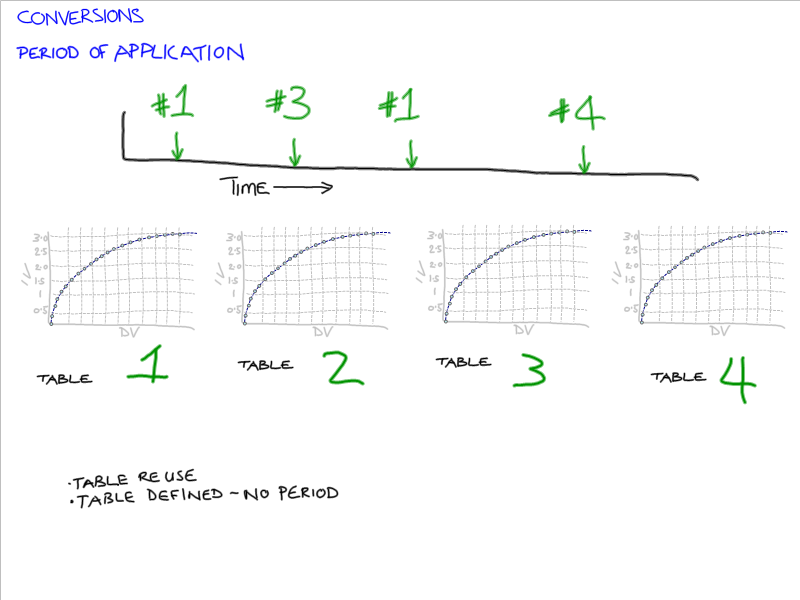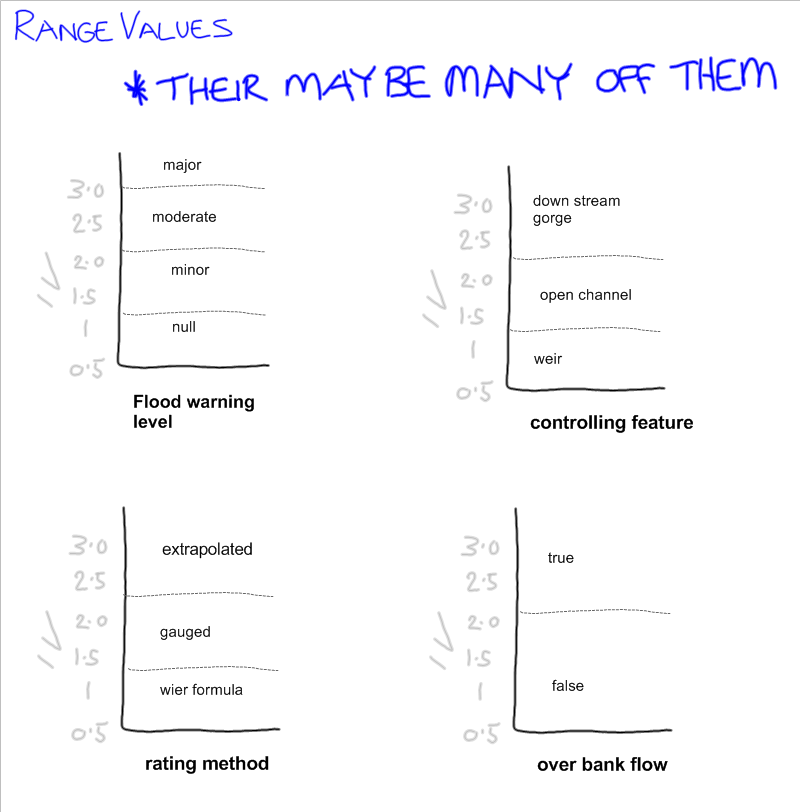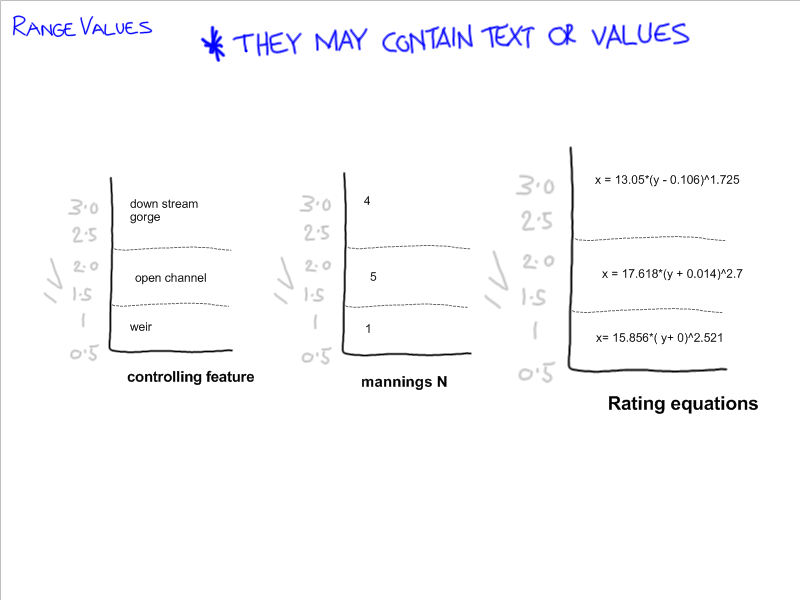You are here: OGC Public Wiki>HydrologyDWG Web>WaterML2Part2>RGSRangeValues (06 Nov 2012, PaulSheahan)Edit Attach
RGS Range Values
This page is for the collection of details that describe the range values concept, further child detail pages may be added if necessary.| Activity register ID | Activity register description https://docs.google.com/spreadsheet/ccc?key=0ArdtTd_VTBTZdGVCZnM3czk1c1NzbVBONWd6Z3dyZHc | Responce |
|---|---|---|
| rgs-4 | The inclusion of user specified user information that varies across the Y scale of a conversion is in scope. This would be used to give further information for the conversion. e.g. Control/Chanel/OverBankFlow Assessment of other sensor application range | Range value tables provide this functionality |
| rgs-6 | Ratings may have the equation that is the source system definition of the rating. This may be supplied using rgs-4. | Range value tables provide this functionality |
| rgs-20 | Conversions can specify Y scale range validated range (within rating), extrapolated range, beyond extrapolation. | Range value tables provide this functionality |
| rgs-21 | There is a need for defining an input range purpose. An input range purpose should be a controlled vocabulary, the semantic meaning of each input range purpose should be defined against the vocabulary. Input range contents may vary over time, so should be referenced by periods of applicability. | |
| rgs-25 | Specific methods for the communication of uncertainty information are not currently agreed across the domain. This is an area of current domain development. The standard should be sufficiently extensible to enable incorporation when a direction is available. | Range values may have a role in provising this functionality. |
| rgs-37 (proposed) | A range value may refer to to a specific value, rather than a range. An example is references to flood extent polygons, the flood extent relates to a specific Y scale value and is not valid for a ranged of Y values (the range is vary narrow). | |
| . | ||
| . | ||
| . |
Purpose
Range tables are a data structure that is similar to a conversion table except that the value applies across a broad input range and the content describes a state or condition that varies with the input range, rather than a conversion.
Range tables may carry information that relates to, or adds value to, a conversion table. E.g. Information describing the rating construction method.A range table may carry information that is of value in it own right. E.g. Stage V. over bank flow condition (confined to channel, over bank flow).
Whilst a range value table may contain information that can be derived by analysis of ratings and gaugings, consensus is that general usage would be that a range table contains information that is new. That is, information that can not be derived from analysis of other info contain in the RGS WML2 document. This is only a usage recommendation or convention, it could not be enforced in schema.
Table name vocabulary
The strength of a range table is achieved though having the definition of its content clearly defined. In a conversion table the is a clear purpose of converting from one parameter to the second parameter. In a range table this is not the case, the table only has the input parameter, the name of the table defines the purpose of the data. This understanding of the definition then enables the user to make good use of the data contained in the table (hopefully). There is an expectation that range table will be used for purposes that we are not aware of e.g. rgs-25. There a need (rgs-21) to have a WaterML2 vocabulary that defines a set of standard range tables? Users would no doubt need to be able to extend the vocabulary.Encode with conversion points?
Encoding a range value with a conversion table will most likely result in many IV values not having range values. This means that logic is required to extract the range information from the structure. The telecon of 20/9 recommended that table should be encoded on their own and that a XML table structure would only contain a single range table. Multiple table structures would be required for multiple ranges.Encoding
Is there a need for the encoding to be suitable for use with a style sheet to enable the information to presented in HTML?Range table content typing
Is there a need to type the content of a range value, would the typing be best completed in the definition of the range name. e.g. Mannings N table contains numbers.Range table concepts
Below are a number of white board slide on range table concepts, these include:- A Site / WML2 document may one or contain many different named ranges
- Range tables have a period of applicability
Conversion tables : concepts for reference


Range tables concepts.
rgs-20 : rating method.
 rgs-6 - Table equations
rgs-6 - Table equations
 -- PaulSheahan - 22 Sep 2012
-- PaulSheahan - 22 Sep 2012 | I | Attachment | Action | Size | Date | Who | Comment |
|---|---|---|---|---|---|---|
| |
RangeValues.v2_1.png | manage | 43 K | 22 Sep 2012 - 21:37 | PaulSheahan | |
| |
RangeValues.v2_2.png | manage | 69 K | 22 Sep 2012 - 21:37 | PaulSheahan | |
| |
RangeValues.v2_3.png | manage | 59 K | 22 Sep 2012 - 21:38 | PaulSheahan | |
| |
RangeValues.v2_4.png | manage | 24 K | 22 Sep 2012 - 21:38 | PaulSheahan | |
| |
RangeValues.v2_5.png | manage | 68 K | 22 Sep 2012 - 21:38 | PaulSheahan | |
| |
RangeValues.v2_6.png | manage | 66 K | 22 Sep 2012 - 21:38 | PaulSheahan | |
| |
RangeValues.v2_7.png | manage | 48 K | 22 Sep 2012 - 21:39 | PaulSheahan | |
| |
Range_Values.v2.pdf | manage | 456 K | 22 Sep 2012 - 21:39 | PaulSheahan |
Edit | Attach | Print version | History: r3 < r2 < r1 | Backlinks | View wiki text | Edit wiki text | More topic actions
Topic revision: r3 - 06 Nov 2012, PaulSheahan
- Webs
-
 AIP8
AIP8
-
 ASTROdwg
ASTROdwg
-
 AgricultureSummit
AgricultureSummit
-
 AustraliaNewZealandForum
AustraliaNewZealandForum
-
 AviationDWG
AviationDWG
-
 BigDataDwg
BigDataDwg
-
 BusinessValueCommittee
BusinessValueCommittee
-
 CATdiscuss
CATdiscuss
-
 CDBswg
CDBswg
-
 CRSdefinitionResolver
CRSdefinitionResolver
-
 CRSdwg
CRSdwg
-
 CanadaForum
CanadaForum
-
 ChinaForum
ChinaForum
-
 CitSciIE
CitSciIE
-
 CitizenScienceDWG
CitizenScienceDWG
-
 ClimateChallenge2009
ClimateChallenge2009
-
 CoveragesDWG
CoveragesDWG
-
 DiscreteGlobalGridSystemsDWG
DiscreteGlobalGridSystemsDWG
-
 EMSpectrumDWG
EMSpectrumDWG
-
 EMspectrumDWG
EMspectrumDWG
-
 ERGuidance
ERGuidance
-
 EUforum
EUforum
-
 EarthCube
EarthCube
-
 EnergyUtilitiesDwg
EnergyUtilitiesDwg
-
 GML
GML
-
 GeoSciMLswg
GeoSciMLswg
-
 GeoScienceDWG
GeoScienceDWG
-
 GeocodingAdHoc
GeocodingAdHoc
-
 Geospatial3DMS
Geospatial3DMS
-
 HealthDWG
HealthDWG
-
 HydrologyDWG
HydrologyDWG
-
 I15swg
I15swg
-
 ILAFpublic
ILAFpublic
-
 ISGdwg
ISGdwg
-
 Ideas4OGC
Ideas4OGC
-
 JAG
JAG
-
 JSONsubGroup
JSONsubGroup
-
 JapanAssistance
JapanAssistance
-
 LandAdminDWG
LandAdminDWG
-
 MLSdwg
MLSdwg
-
 Main
Main
-
 MarineDWG
MarineDWG
-
 MassMarket
MassMarket
-
 MetOceanDWG
MetOceanDWG
-
 NREwg
NREwg
-
 NetCDFu
NetCDFu
-
 NordicForum
NordicForum
-
 OGC
OGC
-
 PointCloudDWG
PointCloudDWG
-
 QualityOfService
QualityOfService
-
 SWEProCitSci
SWEProCitSci
-
 Sandbox
Sandbox
-
 SmartCitiesDWG
SmartCitiesDWG
-
 System
System
-
 TemporalDWG
TemporalDWG
-
 UKIAP2013
UKIAP2013
-
 UrbanPlanningDWG
UrbanPlanningDWG
-
 Vocabulary
Vocabulary
-
 WCTileServiceSWG
WCTileServiceSWG
-
 WPS
WPS
-
 WaterML
WaterML
 The information you supply is used for OGC purposes only. We will never pass your contact details to any third party without your prior consent.
The information you supply is used for OGC purposes only. We will never pass your contact details to any third party without your prior consent. If you enter content here you are agreeing to the OGC privacy policy.
Copyright &© by the contributing authors. All material on this collaboration platform is the property of the contributing authors.
Ideas, requests, problems regarding OGC Public Wiki? Send feedback


